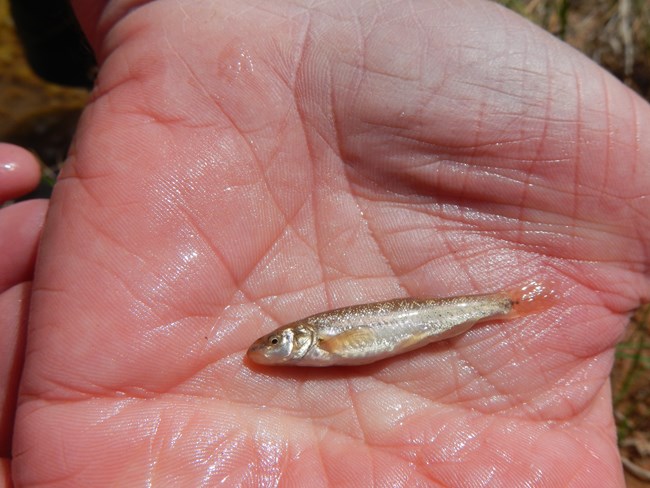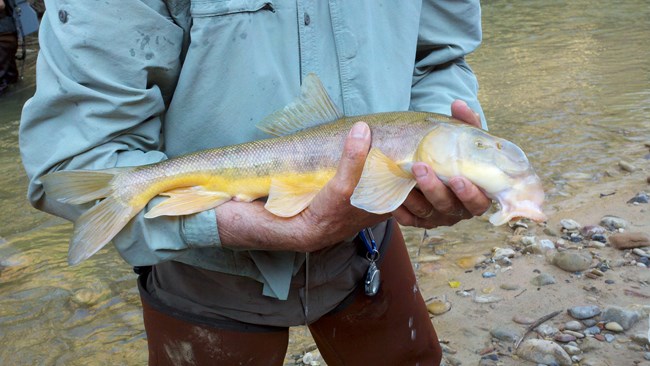
Zion National Park Photo The Virgin River HabitatFlowing through Zion National Park are the North and East forks of the Virgin River and their various tributaries. These streams are all part of the Virgin River drainage, which is part of the larger Colorado River Basin. There are six fish species native to the Virgin River Basin, four of which reach the headwaters where Zion is located. Three of the six species are found widely in the Colorado River system, and three are found only in the Virgin River. The rivers of Zion National Park retain their full complement of four species of native fish in healthy populations. Such a statement cannot be made for any other comparable river system in the southwest U.S. This rare and desirable condition is only possible because stream flow in the park is essentially natural, with all of the floods, sediment transport and periods of low flow that have always occurred. The fish of the Virgin River drainage have evolved adaptations to the unique local conditions, including heavy silt loads, frequent floods, and wide fluctuations in water temperature and discharge. Unfortunately, outside of the park the native fish of the Virgin River have experienced population declines due to habitat fragmentation and the introduction of non-native species. Efforts are currently underway to protect rivers that provide good habitat, and restore areas of lost or degraded habitat to provide for the recovery and protection of the native fish. Native Fish of Zion

Zion National Park Photo Virgin River Spinedace(Lepidomeda mollispinis) Description: 4-6 inches long with a shiny silver body. 3 year lifespan. Within Zion, they are found in the North Fork and East Fork of the Virgin River. Diet: Opportunistic omnivore, but primarily insectivorous. Fun Fact: Named for the Virgin River running through Zion National Park and the Narrows, these Spinedace are endemic to the Virgin River drainage. 
Arches National Park Photo Speckled Dace(Rhinichthys osculus) Description: 2-3 inches long, olive/yellow side and back with dark flecks. 3 year lifespan. Located in all of Zion’s waters with some fish. Diet: Feeds on mostly insects, some plant material and zooplankton. Fun Fact: Both the lower Colorado River and Sevier River genotypes of Speckled Dace are present in Zion National Park. This indicates that both watersheds crossed through this area at some point in the past. 
Zion National Park Photo Desert Sucker(Catostomus clarkia) Description: 8-15 inches long with brown/green backs transitioning to silver/tan/yellow stomachs. Large variation in coloring. 8-10 year lifespan. Found in all of Zion’s waters with some fish. Diet: Feed on diatoms and algae (including any animal material in the algae). Fun Fact: Desert Suckers utilize a hard, protruding ridge in their lower lip made of cartilage to scrape rocks along the stream bed for algae. 
Zion National Park Photo Flannelmouth Sucker(Catostomus latipinnis) Description: 12-25 inches long. Dark brown/green back, yellow/orange side, and white underside. 10 year lifespan. Located in the North Fork, East Fork, and North Creek in Zion National Park. Diet: Mostly eat algae, as well as some invertebrates and plant material. Fun Fact: Flannelmouth Suckers also feed on algae like Desert suckers, but instead have a fleshy lower lip that is split into two lobes down the middle. Their lips extend out and have taste buds on the surface to help find food. Non-Native Fish of Zion
Zion (all present in low numbers): Rainbow Trout - Oncorhynchus mykiss 
Zion National Park Photo Conservation EffortsZion National Park works in conjunction with the Virgin River Program. The Virgin River Program is a large cooperative with National Park Service, Utah Department of Natural Resources, U.S. Fish and Wildlife Service including others. The program helps Zion to monitor fish species within the park's waterways, controlling non-native fish populations, and assisting in watershed planning measures. 
Fishing in National Parks
National Parks offer many fishing opportunities. 
Virgin River Program
The Virgin River Program is a collaborative effort between local, state, and federal partners to promote river enhancement and protection. 
Animals
A variety of wildlife can be found in Zion. |
Last updated: August 31, 2024
